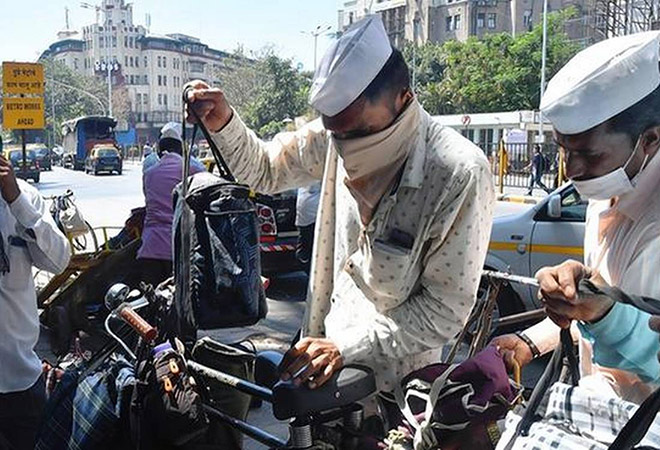
Since the relaxation of the lockdown from the beginning of June, life across Mumbai has shown increasing signs of limping out of its slumber. However, some businesses that have for long symbolised and shaped the character of the megacity are continuing to face an existential threat. One such victim of the lockdown’s collateral damage are the iconic ‘dabbawalas’ (lunchbox carriers), who, through their sheer ingenuity, have gained global recognition for their failproof business processes. Unemployed and broke, many dabbawalas left for their hometowns in western Maharashtra when it became clear that the lockdown imposed for 21 days on 24 March will get extended for an indefinite period. But more misery awaited several of them. The Nisarg cyclone that made its landfall on coastal Maharashtra on 3 June wrought widespread damage to their fields and houses. Those who did not have any homes to return to in the villages, continue to fend for themselves in the city, scavenging for whatever work they could find to sustain their families.
Humble beginnings
In her book ‘Mumbai’s Dabbawala – The uncommon story of the common man’, one of the finest accounts of the dabbawalas’ amazing 130-year journey, noted Marathi writer Shobha Bondre notes that the business of ferrying lunchboxes from homes to offices and back started in 1890, when Mahadeo Bacche, a migrant labourer from Pune district’s Maval taluka, came upon an innovative idea while working as a loader at the Bombay port. Long before the restaurant business mushroomed and the famous khau gallis (street food lanes) were established, most white-collared workers in the Fort area used to carry lunch from home. Eyeing an opportunity, Bachhe started collecting the lunchboxes from homes and delivering them to the offices in the area.
Bachhe soon recognised the potential of this business and called other unemployed men from and around his village to join him. The following decades saw extensive reclamation by the British rulers, leading to the city’s rapid geographical expansion and population growth. The extension of the suburban railway also created enhanced employment opportunities with assured incomes, which drew more men from western Maharashtra to work as tiffin delivery boys. They organised themselves under the Nutan Mumbai Tiffin Box Suppliers Trust, a charitable organisation, which, in 1956, was formally registered as the Nutan Mumbai Tiffin Box Suppliers Association (NMTBSA). Clad in their trademark uniform of white pyjamas and shirts and donning the ‘Gandhi topi’, these men from Junnar, Rajguru Nagar, Sangamner, Akola, Mulshi, Ambegaon, and several other talukas and villages around Pune eventually came to be recognised as the ‘dabbawalas’ of Bombay.
As the city as well as their clientele grew, so did the logistical complexities of the tiffin delivery service. Comprising a bunch of men who were mostly illiterate or early school dropouts, the dabbawalas came up with their own unique colour coding system that ensured that the tiffins were delivered efficiently and accurately. Riding a bicycle, a dabbawalla would collect lunchboxes from homes by 9:30 AM. The three- or four-tiered lunchbox would be put in a unique colour-coded tin canister, the ‘dabba’. Finishing his daily morning round of about 30 homes, the dabbawala would ride to the nearest suburban railway station, where other dabbawalas too would have gathered from different areas. They dabbas would get quickly sorted as per the delivery area-specific colour codes and loaded on the trains. The loading and off-loading of dabbas would happen at all stops along the journey. At each station, the offloaded dabbas would be sorted once again for delivery to the respective offices by 1 PM. Once picked up, a dabba would thus change six to eight hands before getting delivered to the office, without a single mix-up. The empty dabbas would be collected at 2 PM, and following the same pattern, make their return journey to each home by 6 PM.
No-tech six sigma operations
Over the years, the dabbawalas continued to hone their logistics with finesse. They shot to limelight in 1996, when their work was captured in a documentary titled ‘Dabbawalas, Mumbai’s Unique Lunch Service’ followed by an article ‘Fastest Food: It’s Big Mac vs Bombay’s Dabbawalas’ published by the Christian Science Monitor in 2001 and another full-length documentary by the Carnegie Mellon University. However, their biggest achievement came when Prince Charles made a scheduled stopover at the Churchgate station during his official visit to Mumbai in 2003 to interact with the dabbawalas. So impressed was the Prince of Wales, that he invited two NMTBSA office bearers to attend his wedding with Camilla Parker Bowles two years later. In 2005, IIM Ahmedabad published its research paper titled ‘World Class Logistics Operations: The Case of Bombay Dabbawallahs’, while Richard Branson, founder of Virgin Group, spent an entire day with them, learning their tricks of the trade. In 2001, Forbes magazine awarded the dabbawalas the Six Sigma certification for 99.99 percent accuracy – one mistake per 16 million transactions. The Six Sigma certification was once again accorded to the dabbawalas by a Harvard Business School study conducted in 2010. Four years later, the dabbawalas’ logistics system was introduced as part of a course taught by UC Berkeley’s Graduate School of Journalism. The world-class service delivery standards with zero technology input have been as an enigma to unravel for global logistics companies including FedEx and e-commerce giants Amazon and Flipkart.
Once feeding lakhs, dabbawalas are staring at starvation
Currently, around 5,000-odd dabbawalas ferry over 200,000 dabbas daily. They earn quite a meagre salary of Rs. 8,000 per month. Most of them reside in slums, which are the hotbeds of Covid-19. As the news of their financial woes spread, several city-based NGOs and film stars came forward to help them with daily rations. In association with the Make Earth Green Again (MEGA) foundation, Maharashtra cabinet minister Aslam Shaikh, who is also the city’s guardian minister, distributed ration kits to 2,500 dabbawalas. He also urged the Chief Minister to announce a direct benefit transfer of up to Rs. 5,000 to the bank account of each dabbawalla till such time the local trains resumed full-capacity operations and offices started functioning normally across Mumbai. But such help has been sporadic, fragmented and mostly short-lived.
Following the death of Santosh Jadhav, a dabbawala, to Covid-19 on 24 June, the NMTBSA has renewed its plea for Rs. 2,000 per dabbawala as monthly sustenance money. Their plea, is reportedly, still under consideration.
Shiv Sena, the party that leads the incumbent tri-partite Maha Vikas Aghadi government in Maharashtra was formed by the late Bal Thackeray, the current Chief Minister’s father, to restore the rights and privileges of the “sons of the soil” and safeguard the “Marathi asmita (pride)”. Not many in Mumbai embody the Maharashtrian identity, spirit and cultural ethos more than the dabbawalas. It is high time the Shiv Sena lived up to the cause for which it was supposedly established. The government should immediately start the direct benefit transfer of Rs. 2,000 per dabbawala per month as sustenance money. This should be continued till at least November 2020, in line with the free rations scheme of the central government. The government must also disburse an interest-free loan to the NMTBSA and the cooperative credit society managed by the association so that each dabbawala has access to adequate funds in case he or any member of his family needs hospitalisation for Covid-19.
The glorious contribution of the dabbawalas was etched forever on the city when a larger-than-life statue of a dabbawalla was installed at the Haji Ali junction in 2017. The hands that fed lakhs of citizens daily are today in dire need of financial help to feed their own families. It is time for the citizens, and importantly, the government, to rise above mere symbolism and help these men who through their resourcefulness and imagination put Mumbai on the world map.
The views expressed above belong to the author(s). ORF research and analyses now available on Telegram! Click here to access our curated content — blogs, longforms and interviews.




 PREV
PREV


